
|
NOTE: You are viewing the OLD VeloceToday website. We are in the process of moving some of the old articles from the OLD site to the NEW site.
|

|

|

|


Home
Cars
Racing
News
People
Lifestyle
Events

|

|

|
Events
|

|

|
June 6th, 2007
Mille Miglia 2007
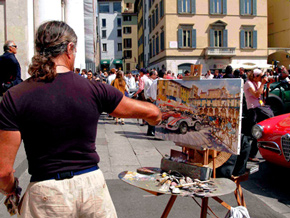
|
Photos by Alessandro Gerelli
We showcase a particular set of cars as photographed by Alessandro Gerelli at this year's running of the Mille Miglia. In 2007 they celebrated eighty years since the founding of the event in 1927. The event's website is
millemiglia.it.

1928 Alfa Romeo 6C1500 Super Sport
The significance of Jano's pre war Alfas was recognized very early on. While the Merosi-designed cars were successful, with the advent of Vittorio Jano and the 6C1500, Alfa Romeo took on an entirely new life. The 6C1500 Alfas were introduced in 1927, first with a SOHC unsupercharged six, and ultimately, a DOHC fixed head, supercharged unit which would produce 84 hp and be capable of over 90 mph. A 6C1500 was driven by Enzo Ferrari to victories in the 1927 and 1928 Modena races, and one like the example pictured here won the 1928 Mille Miglia. The 6C1500 was superseded by the fabulously successful 6C1750. Most examples of the early Alfas found their way to appreciative enthusiasts in both Great Britain and the U.S. which helped to ensure their long term survival.
|

1933 Alfa Romeo 8C2300 Touring
Thanks in large part to the life-long efforts of Alfa enthusiast Simon Moore,
we know that this Alfa 2.3 is serial number 2311202, with a Touring body on a long wheelbase chassis.
In 1933, five very similar, long wheelbase Touring bodied 8C2300s were built for long distance racing. It was part of the Alfa Romeo Tradition: Alfa had already won at Le Mans in 1931, 1932, and it would win again in 1933 and 1934, all with 2300s such as this example. The car, painted a French racing blue, was driven at Le Mans in 1933 by Luigi Chinetti and Cortese but was retired. It survived a long list of owners and years of racing in Australia before being purchased by a Dutch enthusiast, and has been actively campaigned since 1986 in many vintage events.
|

1951 Ferrari 340 Vignale
Michael Sheehan, today still very much a part of the Ferrari scene, was the savior of this 4.1 Liter Ferrari Vignale, chassis 0082A, winner of the 1951 Mille Miglia. After a heroic drive by Luigi Villoresi, the beautiful but hard-to-handle coupe went to Portugal for a few good seasons of racing, found a home in New Jersey, and then on to California where it became a Ferrari-Corvette. In 1986, Sheehan restored the car with the original engine which had been in the hands of Ernst Beutler of Michigan. Ferrari's long participation in the Mille Miglia is well documented in the excellent book, "Red Arrows".
|

1952 Ferrari 212 Inter
The 212 was a crucial step to the 250, but at the same time the 100--odd cars built as 212 Exports and Inters were overshadowed and outdragged by the big Lampredi engined cars such as the 340 Vignale. Ecurie Francorchamps ordered this Touring coupe in 1952 on a 212 Inter chassis. The original Touring barchetta/ berlinetta design was getting a bit long in the tooth;
this 225 was one of the last Touring bodied cars, as soon Pininfarina would become the dominant Ferrari coachbuilder, and eclipse Touring, Vignale and Ghia .
|

1952 Ferrari 225 Vignale
Chassis number 0176ED has been recently rebodied to its original configuration. This 225 Export Ferrari was built for Scuderia Guastalla and placed third at the 1952 Monaco Grand Prix which was run for sports cars in that year. Its seems that several early Ferraris had rather strange bodies, including 0086E.
In the early 1950s 0176E was rebodied as more conventional Vignale spider and the engine was used to power a motor boat. The 225s were Colombo engined cars with a displacement of 2715 cc and produced about 210 hp. The 225 series was the last step in the evolution of the 3 liter 250GT.
|
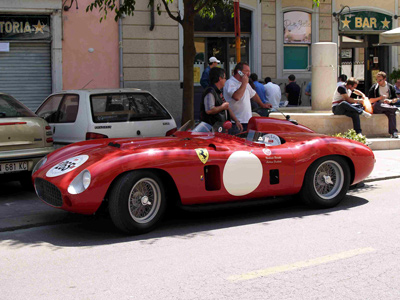
1956 Ferrari 860 Monza
In 1955, Ferrari built a small series of 860 Monzas, four cylinder cars with a total displacement of 3431cc. The model raced throughout 1955 without a victory, but in March 1956, the 860 placed first and second at Sebring, the winning car (as seen here) driven by Fangio and Castellotti. In second was yet another 860, piloted by Musso and Schell. That year Sebring hosted a full battery of Jaguar D Types, the Aston Martin factory team, John Fitch and the Corvettes, the new Maserati 3 liters and two factory Porsches.
The race was brutal, even Fangio finished without brakes and only a hint of a clutch. It was to be an important win for Ferrari and the establishment of Ferrari in America via Luigi Chinetti.
|
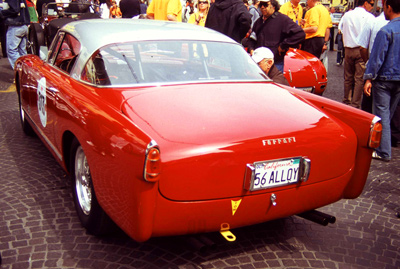
1956 Ferrari 250GT Ellena
Developed from the 212 and 225 series, the legendary 250GT first saw true series production in the guise of the PF/Boano/Ellena coupes. The car was designed by Pininfarina, and the first prototypes were built by that firm. However, regular production responsibilities went to Mario Felice Boano. In 1957, Boano went to Fiat and his son-in-law, Ezio Ellena, changed the name of the family firm to Ellena and continued the production of the PininFarina designed Ferraris. Several all alloy Ferrari Ellena took part in the Mille Miglia and in 1957 one finished 14th in the GT category. The next month Ritchie Ginther won the first American “GT” race at Lime Rock with a 250GT Boano.
|
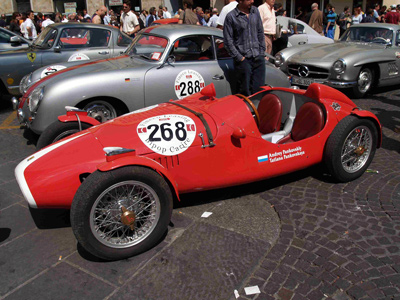
Bandini 750 Siluro
Bandinis entered the Mille Miglia in 1949, 1953-57, but never had a great deal of luck, always retiring with mechanical problems or accidents.
Ilario Bandini, garage owner and creator of the tiny racers, first drove a car of his making in the Mille Miglia in 1949. This early Bandini had a Fiat four cylinder 1100 block mated to a 6c2500 Alfa head, shortened by two combustion chambers. Later, most Bandinis, like the one pictured here, were powered by 750 cc Crosley based engines, the most effective being a DOHC head built by Bandini. According to the recent book "Bandini" many, if not a majority, of Bandinis built in the 1950s and early 60s were sent to the U.S. Out of 75 Bandinis built, 45 are known to still exist.
|
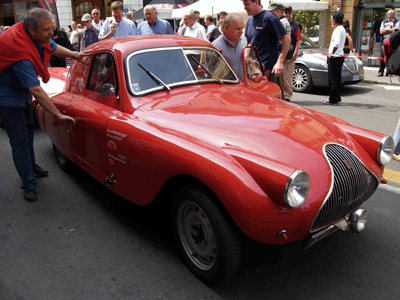
1938 Fiat 1100 508MM
The Fiat 1100, also known as the 508C, was introduced in 1937, replacing the famous Balilla . As with the Balilla, a Mille Miglia coupe was part of the factory lineup. Designated the 508CMM, it put out 42 hp at 4400 rpm, and the Carrozzeria Savio body was very aerodynamic. Taruffi won the 1100cc class with the new 1100 in 1938 at an average speed of just under 70 mph. The version pictured here was entered in the 1940 Mille Miglia and defined as the “new” type 508C MM. Earlier and later versions had the headlights built into the fenders, but all had the distinctive, pointed, fastback body style. After the war, this line of Fiats continued as the 1100S series.
|
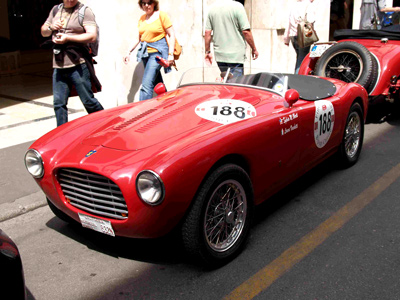
1952 Siata 300 BC
The very attractive Siata 300BC, first seen at the Geneva Show in 1952, was built with both Fiat/Siata 1100cc engines and the 750cc Crosley. The body was by Bertone, and New York importer Tony Pompeo had Siata build a run of 30 cars to be sent to the U.S. in 1952. The price was about $2400 USD with the Crosley engine. 300BC Siatas were raced by the likes of John Bentley, Don Black, Henry Wessells (both later to become very involved with Alfa Romeos), Otto Linton, and Henry Manney III. Some Stateside Siatas were fitted with engines from a Jowett Jupiter, MGTD, Coventry Climax and even a Porsche 1500!
|
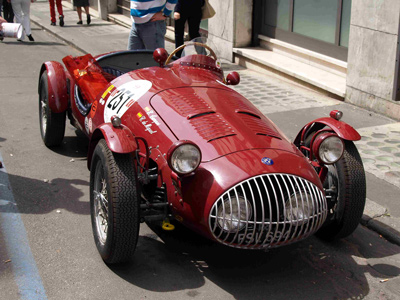
1950 OSCA MT4 2AD 1100
Never judge a car by its body...
this 1950 OSCA MT4 1100cc, chassis 1112, was first sold to Francesco Nissotti, who raced it five times in Italy in 1950 and 1951, with one win, two seconds, and one third place. In 1952 the car went to the U.S. for Frank Bott and Rees Makins. From May of 1952 to June of 1956, 1112 captured at least 10 SCCA class victories, seven in the hands of Makins. The car returned to Italy in 1956, where it was rebodied as a normal OSCA spider. In 1961, Francesco Maria Battibocca took 1112 to a class victory at L’Aquila. On March 31st, 1963, thirteen years after its birth, Battibocca drove it in its last real race at Vallelunga.
|
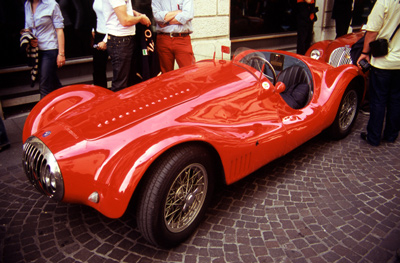
1951 OSCA MT4 2AD 1100
OSCAs weren’t always pretty. In the beginning, they were functional and easy to fabricate, and could qualify for both Formula 2 events by removing the fenders and road equipment. By 1951, however, the cycle fenders had given way to more aerodynamic fixed fenders. This is an MT4 2AD 1100cc OSCA, which developed 92 hp at 6000 rpm. OSCAs were the definitive product of the brothers Maserati; fast, reliable, extremely well made, and until the Porsche 1500 Spyder , virtually undefeated in class.
|
|

|
|

|
|



